St. Boniface, engraved by Cornelis Bloemaert.
Apostle of Germany, date of birth unknown; martyred 5 June, 755 (754); emblems: the oak, axe, book, fox, scourge, fountain, raven, sword. He was a native of England, though some authorities have claimed him for Ireland or Scotland. The place of his birth is not known, though it was probably the south-western part of Wessex. Crediton (Kirton) in Devonshire is given by more modern authors. The same uncertainty exists in regard to the year of his birth. It seems, however, safe to say that he was not born before 672 or 675, or as late as 680. Descended from a noble family, from his earliest years he showed great ability and received a religious education.
His parents intended him for secular pursuits, but, inspired with higher ideals by missionary monks who visited his home, Winfrid felt himself called to a religious state. After much difficulty he obtained his father’s permission and went to the monastery of Adescancastre on the site of the present city of Exeter, where, under the direction of Abbot Wolfhard, he was trained in piety and learning. About seven years later he went to the Abbey of Nhutscelle (Nutshalling) between Winchester and Southampton. Here, leading an austere and studious life under Abbot Winbert, he rapidly advanced in sanctity and knowledge, excelling especially in the profound understanding of scriptures, of which he gives evidence in his letters. He was also well educated in history, grammar, rhetoric, and poetry. He made his profession as a member of the Benedictine Order and was placed in charge of the monastic school. At the age of thirty he was ordained priest. Through his abbot the fame of Winfrid’s learning soon reached high civil and ecclesiastical circles. He also had great success as a preacher. With every prospect of a great career and the highest dignities in his own country, he had no desire for human glory, for the thought of bringing the light of the Gospel to his kindred, the Old Saxons, in Germany, had taken possession of his mind. After many requests Winfrid at last obtained the permission of his abbot.
In 716 he set out for the mission in Friesland. Since the Faith had already been preached there by Wigbert, Willibrord, and others, Winfrid expected to find a good soil for his missionary work, but political disturbances caused him to return temporarily to England. Towards the end of 717 Abbot Winbert died, and Winfrid was elected to succeed him, but declined and induced Daniel, Bishop of Winchester, to influence the monks to elect another.
Winfrid was left free to follow out his intentions, but before going back to his apostolic work he wished to visit Rome and to obtain from the pope the apostolic mission and the necessary faculties. Bishop Daniel gave him an open letter of recommendation to kings, princes, bishops, abbots, and priests, and a private letter to the pope. On Winfrid’s arrival in Rome, in the fall of 718, Pope Gregory II received him kindly, praised his resolutions, and having satisfied himself in various conferences as to the orthodoxy of Winfrid, his morals, and the purity of his motives, on 15 May, 719, he gave him full authority to preach the Gospel to the heathens in Germany to the right of the Rhine, ordering him at the same time to adhere to the Roman practice in the administration of the Sacrament of Baptism, and to consult with the Holy See in case of difficulties.
Engraving of St. Willibrord d’Utrecht by Cornelis Bloemaert
Having received instructions to make to make his first journey through the country, only a tour of inspection, he traveled through Bavaria and found the Church flourishing, with a number of churches and monasteries. In Alamannia, which he crossed on his way to Thuringia, he found similar conditions. Thuringia was considered by Rome as Christian, and the mission of Winfrid was supposed to be that of an authorized reformer. He found the country, however, in a bad condition, St. Kilian had labored with energy, but without success. Duke Gotzbert and some years later his son, Hethan II, both converts of St. Kilian had been murdered, perhaps on account of their injudicious zeal in trying to spread Christianity. Great numbers of their rebellious subjects had lapsed into heathenism, or a mixture of Christianity and idolatry. Winfrid tried to enkindle a missionary spirit in the priests and to make the people live up to the pure precepts of the Christian religion. Though he converted some of the heathens, he did not meet with the success which he had anticipated. On his way to the court of Charles Martel, possibly to interest that prince in the matter, he received news of the death of the Frisian King Radbod, and went to Friesland.
Here he spent three years under the aged St. Willibrord, traveling about with tireless energy and preaching fearlessly as he went. Multitudes of Christians who had fallen away during the persecution of Radbod were brought to repentance and thousands of pagans accepted the Faith. Many of the converts were brought together to lead a religious life under the Rule of St. Benedict. St. Willibrord, feeling the weight of his years, wished to make Winfrid his assistant and successor in the See of Utrecht. Winfrid refused, giving as his main reason that the pope had sent him for missionary work. He therefore left and followed in the wake of the army of Charles Martel as far as Trier. Near this city was the Abbey of Pfalzel (Palatiolum). From there he took with him as a disciple and companion Gregory, a boy of about fourteen or fifteen, afterwards abbot in Utrecht, and continued his journey to Thuringia, where he converted many. He then went into Hessia, where many more were brought into the fold of Christ. With the assistance of two chiefs whom he had converted he established a monastic cell at Amöneburg at the River Ohm (then called Amana) in Upper Hessia, as a kind of missionary center in which native clergy were to be educated.
St. Boniface Route follows the tracks of the funeral procession which, with great interest of the population, brought the body of the missionary and church reformer from Mainz to its final resting place in Fulda in the year 754. The beginning and the end of the route are in the two old, significant bishops’ seats of Mainz and Fulda with their magnificent church buildings. The St. Boniface route ends at the baroque cathedral in Fulda.
While Winfrid was under the jurisdiction of St. Willibrord he had no special reason for reporting to the Holy See, but, now working independently, he considered it his duty to do so. He therefore sent Bynnan, one of his disciples, with a letter to Gregory recounting his labors of the past years and asking for further directions. Bynnan promptly executed his commission and soon returned with the pope’s answer, expressing satisfaction with what had been done and a desire to confer with Winfrid personally.
Winfrid accordingly set out for Rome, taking his course through France and Burgundy. He was warmly welcomed by the pope, who questioned him carefully, made him take the usual oath of allegiance, received from him a profession of faith, and on 30 November, 722 (723), consecrated him a regional bishop, with the name Boniface. Some say that Winfrid had taken this name at the time of his religious profession; others, that he received it on his first visit to Rome. The same discrepancy of opinion exists in derivation from bonum facere or bonum fatum; perhaps it is only an approximate Latinization of Wyn-frith. Pope Gregory then sent Boniface back with letters to his diocesans in Thuringia and Hessia demanding obedience for their new bishop. A letter was also addressed to Charles Martel asking his protection. Boniface himself had received a set of ecclesiastical canons for his guidance.
Boniface returned to Upper Hessia and repaired the losses which occurred during his absence, many having drifted back into paganism; he also administered everywhere the Sacrament of Confirmation. He continued his work in Lower Hessia. To show the heathens how utterly powerless were the gods in whom they placed their confidence, Boniface felled the oak sacred to the thunder-god Thor, at Geismar, near Fritzlar. He had a chapel built out of the wood and dedicated it to the prince of the Apostles. The heathens were astonished that no thunderbolt from the hand of Thor destroyed the offender, and many were converted. The fall of this oak marked the fall of heathenism. Tradition tells us that Boniface now passed on to the River Werra and there erected a Church of St. Vitus, around which sprang up a town which to the present day bears the name of Wannfried. At Eschwege he is said to have destroyed the statue of the idol Stuffo. Thence he went into Thuringia.
In the Vogelsberg mountains of the province of Hessia, where St. Boniface preached and baptized in the 8th century.
The difficulties that confronted him here were very great Christianity had indeed made great progress, but it had become mixed up with heretical tenets and pagan customs. This was due to a great extent to some Celtic missionaries, several of whom had never been ordained, while others had been raised to the priesthood by non-Catholic bishops, though all performed priestly functions. These taught doctrines and made use of ceremonies at variance with the teaching and use of the Roman Church, especially in regard to the celebration of Easter, the conferring of baptism, celibacy, the papal and episcopal authority. Besides, many were wanting in education, some scarcely able to read or write, and equally ready to hold services for the Christians and to offer sacrifices to the idols for the heathens.
A neighboring bishop (probably of Cologne) also gave trouble, by laying claim to a part of the district under Boniface’s jurisdiction and treating his authority as an intrusion, thereby indirectly strengthening the party of the heretics. All this caused him great anxiety and suffering as may be seen from his letters to England. He overcame all, thanks to his episcopal dignity and to his own personality, full of courage and zeal in the cause which he defended, and supported by the authority of the pope and of Charles Martel. His friends helped him not only by their prayers, but also by material aid. Many valuable books, ecclesiastical articles and the like were sent to him with words of encouragement.
Numbers of men and women went to Germany at different times to be his helpers. Among them were Lullus, Denehard, Burchard, Wigbert, Sola, Witta (called also Wizo and Albinus), Wunibald, Willibald and the pious women Lioba, Chunihild, Chunitrude, Berthgit, Walburga, and Thecla. With these, and others recruited in Thuringia and elsewhere in Germany, he continued his labours. The number of the faithful increased wonderfully, including many of the nobility and the educated of the country. These assisted him in the building of churches and chapels. Boniface took care to have institutions in which religious life would be fostered. In Thuringia he built the first monastery Ohrdruf on the River Ohrn near Altenberga. He appointed Thecla Abbess of Kitzingen, Lioba of Bischofsheim, and Walburga of Heidenheim.
St. Boniface, Painted by Alfred Rethel
Pope Gregory II died 11 February, 731, and was succeeded on 18 March by Gregory III. Boniface hastened to send a delegation to the new pontiff, to pay his respects and to assure him of his fidelity. The answer to this seems to be lost. In 732 Boniface wrote again and stated among other things that the work was becoming too much for one man. Gregory III congratulated him on his success and praised his zeal, in recognition sending him the pallium, and making him an archbishop, but still without a fixed see. He gave him instructions to appoint bishops wherever he thought it necessary.
Boniface now enlarged the monastery of Amöneburg and built a church, dedicating it to St. Michael. Another monastery he founded at Fritzlar near the River Eder, which was completed in 734. The church, a more magnificent structure, was not finished before 740. In 738 Boniface made his third journey to Rome, intending to resign his office and devote himself exclusively to the mission among the Saxons. He was accompanied by a number of his disciples, who were to see true Christian life in the centre of Christianity. Gregory III received him graciously and was rejoiced at the result of Boniface’s labor, but would not allow him to resign. Boniface remained in Rome for about a year and then returned to his mission invested with the authority of a legate of the Holy See. His first care on his return was the Church in Bavaria.
St. Boniface cutting down Thor’s oak.
In 715 (716) Duke Theodo had come to Rome out of devotion, but probably also to secure ecclesiastical order in his provinces. Gregory II sent three ecclesiastics with instructions to do away with abuses. Their work, however, was rendered futile by the death of Theodo in 717 and the subsequent political quarrels. Boniface had twice passed through the country. Now with the help of Duke Odilo and of the nobles he began the work of reorganization acting entirely according to the instructions of Gregory II. He examined the orders of the clergy, deposed the obstinate, reordained those whose ordination he found invalid, provided they had erred through ignorance and were willing to submit to authority.
He made a new circumscription of the dioceses and appointed bishops for the vacant sees, viz., the Abbot John to the See of Salzburg, vacant since the death of St. Rupert in 718; Erembert to Freising, vacant since the death of his brother, St. Corbinian, in 730; Gaubald for Ratisbon. Passau had been established and provided for by the pope himself through the nomination of Vivilo. About this time Boniface founded the new Diocese of Buraburg, and named Witta as its bishop. This diocese existed for only a short time, during the administration of two bishops, and was then joined to Augsburg. Somewhat later the dioceses of Eichstätt and Erfurt (Erphesfurt) were formed, and Willibald was consecrated bishop for the former about October, 741; for the latter Boniface appointed as first (and last) bishop Adalar, who, it seems, never received episcopal consecration, as he is continually spoken of as a priest. Burchard was chosen for Würzburg.
St. Willibrord (r) and St. Boniface (l) by Jan Franse Verzijl
Charles Martel had died 22 October, 741, at Quiercy on the Oise and was succeeded by his sons Carloman and Pepin. In Rome Pope Gregory III died 28 November, 741, and was followed by Zachary. Carloman asked Boniface, his former preceptor, to a consultation. The result of this was a letter to the pope in which Boniface reported his actions in Bavaria and asked advice in various matters. He also stated the wish of Carloman that a synod be held. In answer Pope Zachary, 1 April, 742, confirmed the erection of the dioceses, sanctioned the holding of the synod, and gave the requested information. The synod, partly ecclesiastical and partly secular, was held 21 April, 742, but the place cannot be ascertained.
The bishops appointed by Boniface were present and several others, but it was mainly the authority of Boniface and the power of Carloman that gave weight to the first German synod. Among its decrees the most noteworthy are those ordaining the subjection of the clergy to the bishop of the diocese and forbidding them to take any active part in wars, to carry arms, or to hunt. Very strict regulations were made against carnal sins on the part of priests and religious. The Rule of St. Benedict was made a norm for religious. Laws were also enacted concerning marriage within the forbidden degrees of kindred. A second national synod was held 1 March, 743, at Liptina in Hainault, and another at Soissons, 2 March, 744. In this synod a sentence of condemnation was passed against two heretics, Adalbert and Clement, the former a native of Gaul, the latter of Ireland. They were strain condemned in 745 and also at a synod held in Rome. Several other synods were held in Germany to strengthen faith and discipline. At the request of Carloman and Pepin the authority of Boniface over Bavaria was confirmed and extended over Gaul.
In 744 St. Willibrord, Bishop of Utrecht, died, and Boniface took the diocese under his charge, appointed an assistant or chor-episcopus. About the same time the See of Cologne became vacant through the death of Ragenfried, and it was the intention of Boniface as well as the wish of Pope Zachary to make this his archiepiscopal see, but the clergy opposed.
Before the project could be carried out the Diocese of Mainz lost its bishop through the deposition of Gewilieb who led a very irregular life and had killed the slayer of his father, who was his predecessor in the episcopal office. Pope Zachary, 1 May, 748 (747), appointed Boniface Archbishop of Mainz and Primate of Germany. The new archdiocese comprised the dioceses of Tongem, Cologne, Worms, Speyer, Utrecht, and the dioceses erected by Boniface himself: Buraburg, Eichstätt, Erfurt, and Würzburg. Of Augsburg, Coire, and Constance the decree does not speak, but they are shortly afterwards mentioned as belonging to the province. After a few years Boniface was able to reconcile his enemies with the Holy See, so that the supremacy of the pope was acknowledged in Great Britain, Germany, and Gaul, as well as in Italy.
The martyrdom of St. Boniface
In 747 Carloman resigned his share of the government to his brother Pepin and left to spend the remainder of his days as a monk. He built a monastery in honor of St. Silvester at Soracte near Rome, and later retired to Monte Cassino. His motives for this are not known, but perhaps he was frightened at the severity of the measures he had felt himself obliged to use in order to obtain a union among the German tribes. Pepin, now the sole ruler, became the founder of the Carlovingian dynasty. That Boniface had anything to do with the dis-establishment of the old royal family and the introduction of a new one cannot be proved. He did not mingle in the politics of the country, except in this, that he did all in his power to convert the people to the true Faith, and to bring them into spiritual subjection to the Roman pontiff. It is generally stated that Boniface anointed and crowned Pepin by order of the pope, though this is denied by some.
The rest of his life Boniface spent in confirming what he had achieved in Germany. This he did by frequently holding synods and by enforcing the sacred canons. He did much for true religious life in the monasteries, especially at Fulda, which had been established under his supervision by St. Sturm, and into which Boniface returned yearly to train the monks and to spend some days in prayer and meditation. At his request Pope Zachary exempted the abbey from all episcopal jurisdiction and placed it under the immediate care of the Holy See. This was something new for Germany, though already known and practiced in Italy and England. It seems that Boniface’s last act as Archbishop of Mainz was the repudiation of the claim of the Archbishop of Cologne to the diocese of Utrecht. The matter was laid before Pepin, who decided against Cologne. The same decision must have been given by Pope Stephen II (III) who had become the successor of Zachary, 26 March, 752, for after that time no further claim was made by Cologne. No change was made until the ninth century, when Cologne was made an archdiocese and Utrecht one of its suffragan sees. Boniface appointed Abbot Gregory as administrator of Utrecht, and Eoban, who had been assistant, he took as his companion.
Reliquary of St. Boniface in the Estonia Esztergom Cathedral Treasury.
When Boniface saw that all things had been properly taken care of, he took up the work he had dreamed of in early manhood, the conversion of the Frisians. With royal consent, and with that of the pope previously given, he in 754 resigned the Archdiocese of Mainz to his disciple Lullus, whom in 752 he had consecrated bishop, again commenced a missionary tour, and labored with success to the East of the Zuider Zee. Returning in the following year, he ordered the new converts to assemble for confirmation at Dorkum on the River Borne. The heathens fell upon them and murdered Boniface and fifty-two companions (according to some, thirty-seven).
Soon afterwards, the Christians, who had scattered at the approach of the heathens, returned and found the body of the martyr and beside him the bloodstained copy of St. Ambrose on the “Advantage of Death”. The body was taken to Utrecht, afterwards through the influence of Lullus removed to Mainz, and later, according to a wish expressed by the saint himself during his lifetime, to the Abbey of Fulda. Portions of his relics are at Louvain, Mechlin, Prague, Bruges, and Erfurt. A considerable portion of an arm is at Eichfeld. His grave soon became a sanctuary, to which the faithful came in crowds especially on his feast and during the Octave. England is supposed to have been the first place where his martyrdom was celebrated on a fixed day. Other countries followed. On 11 June, 1874, Pope Pius IX extended the celebration to the entire world. Brewers, tailors, and file-cutters have chosen St. Boniface as their patron, also various cities in Germany. The writings of St. Boniface which have been preserved are: “Collection of Letters”; “Poems and Riddles”; “Poenitentiale”; “Compendium of the Latin Language”; “Compendium of Latin Prosody”; “Sermons” (doubtful).
FRANCIS MERSHMAN (Catholic Encyclopedia)

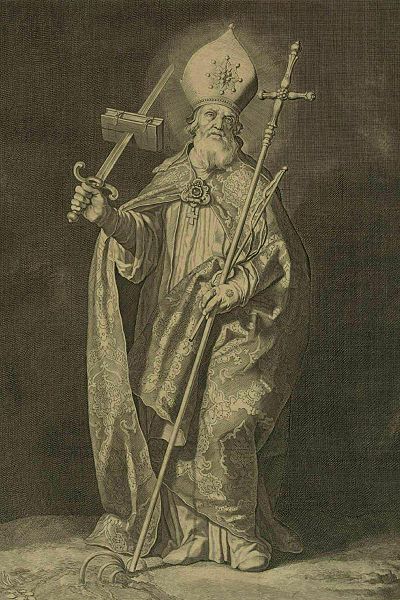
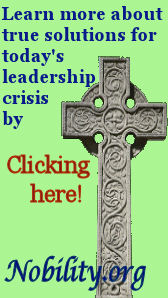
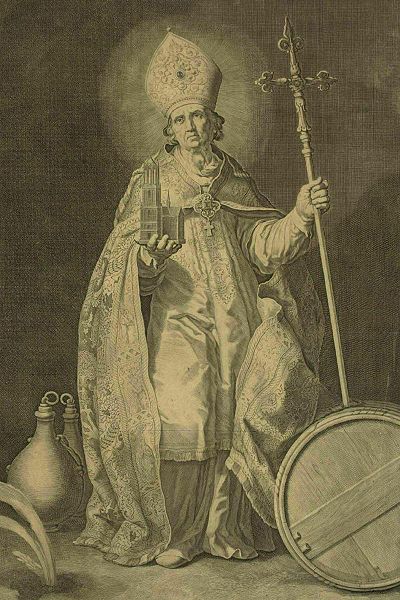

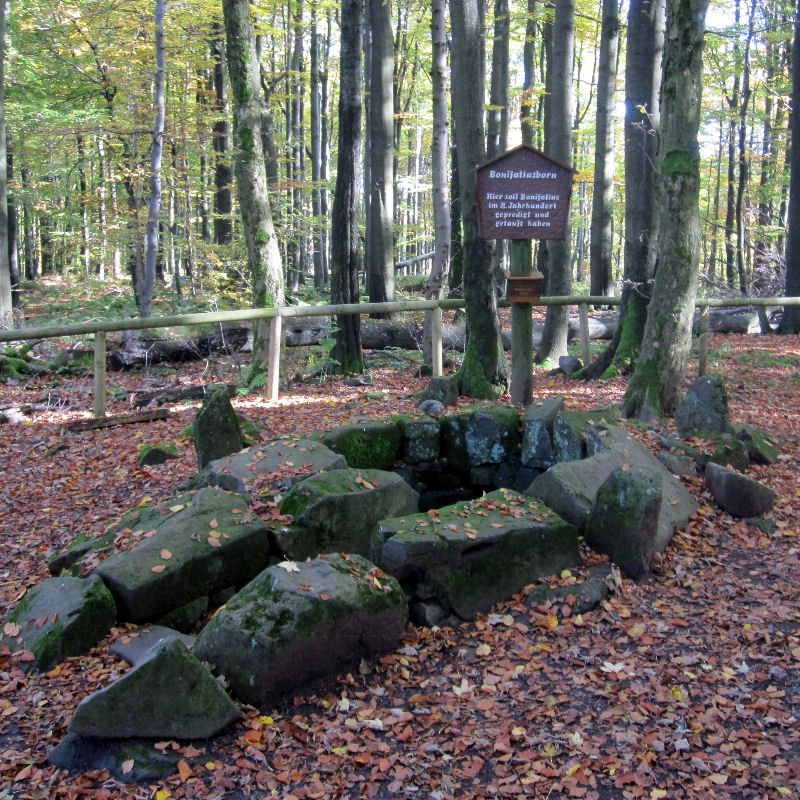
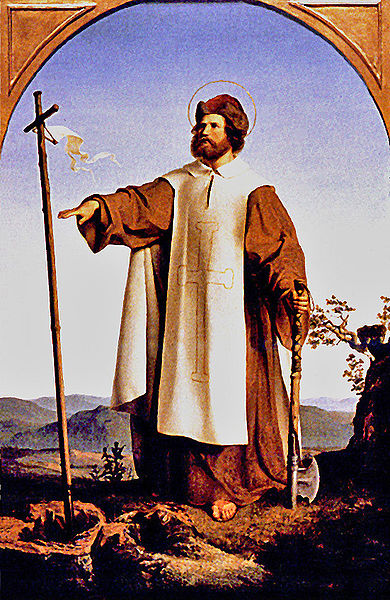
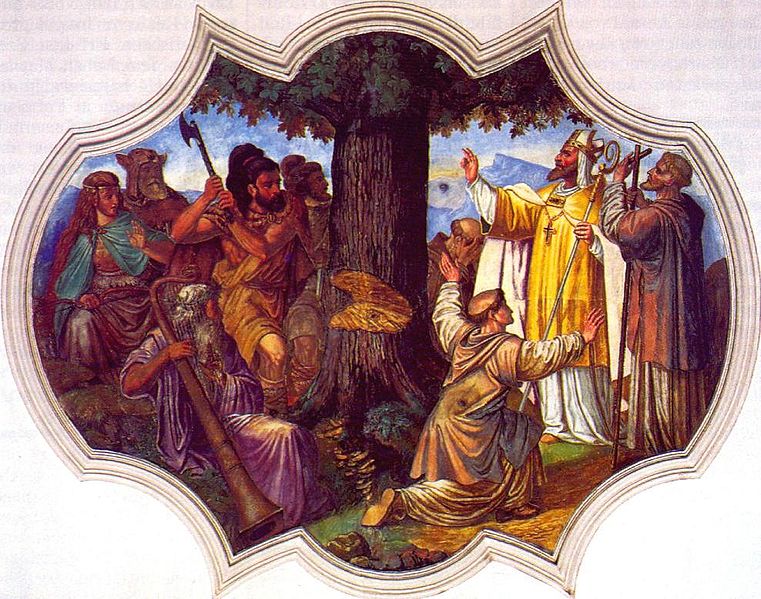

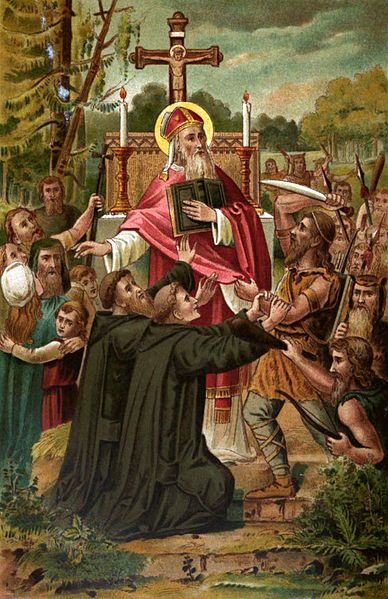
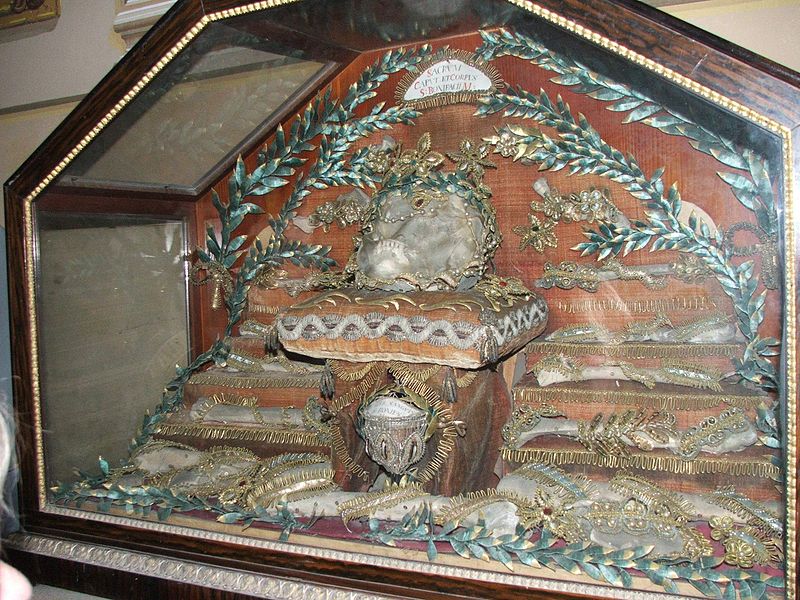
No comments:
Post a Comment